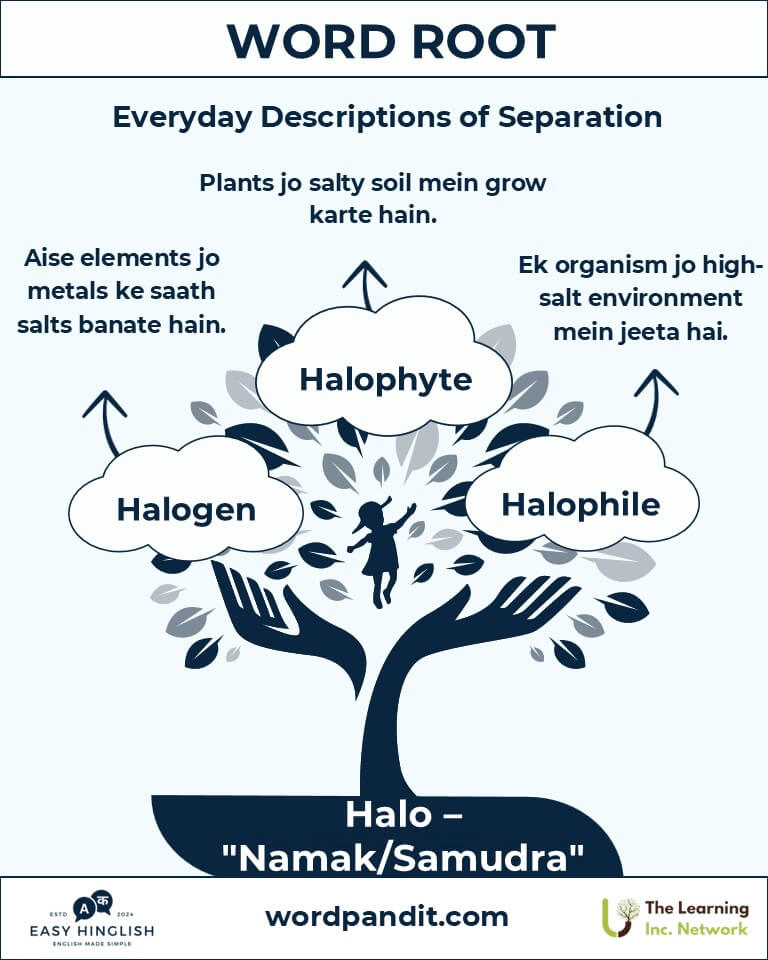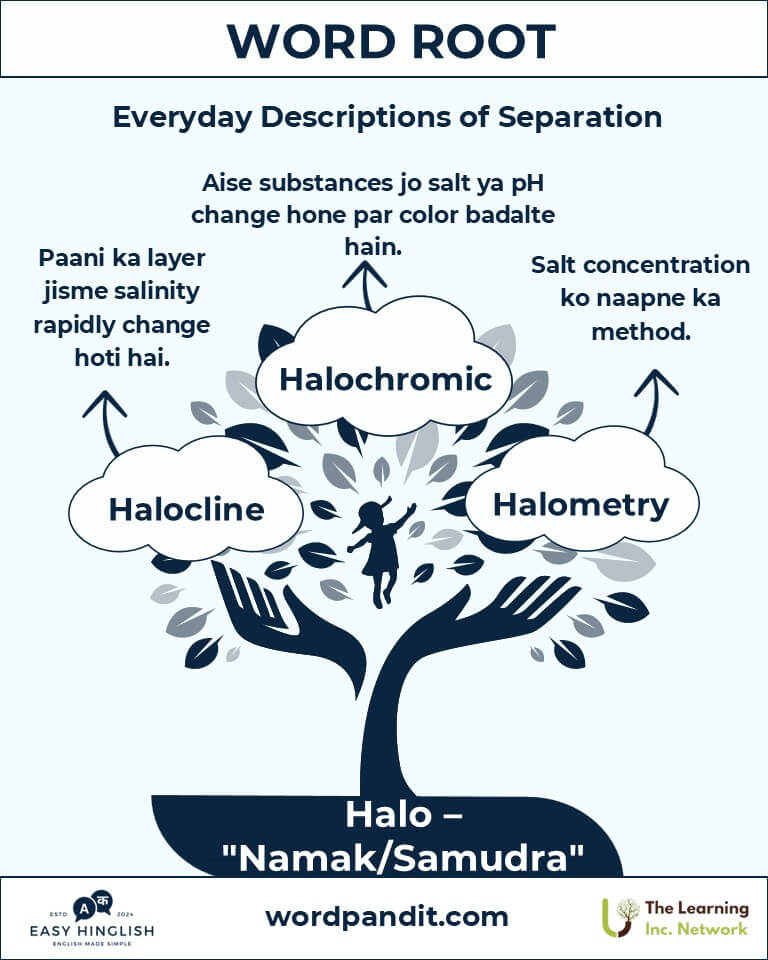Halo: The Salty Connection in Science and Nature
(Halo: Vigyan aur Prakriti mein Salt ka Connection - हॅलो: विज्ञान और प्रकृति में नमक का कनेक्शन)
Discover the fascinating journey of the word root "Halo," derived from the Greek "halos," meaning "salt." From the chemistry of halogens to the resilience of halophytes, "Halo" signifies the essence of salt and its pivotal role in both natural ecosystems and human innovation.

Table of Contents
- Introduction: The Salty Significance of "Halo"
- Etymology and Historical Journey
- Mnemonic: Unlocking the Power of "Halo"
- Common "Halo"-Related Terms
- "Halo" Through Time
- "Halo" in Specialized Fields
- Illustrative Story: "Halo" in Action
- Cultural Significance of "Halo"
- The "Halo" Family Tree
- FAQs about the "Halo" Word Root
- Test Your Knowledge: "Halo" Mastery Quiz
- Conclusion: The Legacy of "Halo"
1. Introduction: The Salty Significance of "Halo"
("Halo" ka Mahatva - "Halo" का महत्व)
Have you ever marveled at the wonders of salt? The word root "Halo," pronounced **"hay-loh"**, captures the multifaceted essence of salt, both in its natural abundance and scientific importance. Originating from the Greek **"halos," meaning "salt,"** this root forms the basis of words that describe elements, ecosystems, and more. From halogens in chemistry to halophytes thriving in salty soils, "Halo" bridges the natural and scientific worlds.

2. Etymology and Historical Journey
(Halo ki Utpatti aur Itihaas - हॅलो की उत्पत्ति और इतिहास)
The root "Halo" traces back to the Greek **"halos,"** originally referring to salt or the sea. In ancient times, salt was revered as a **precious commodity, earning the nickname "white gold."** Over centuries, the term expanded beyond its culinary and preservative uses to become integral in scientific terminology. The **19th century witnessed the rise of "halogen,"** a term coined for elements that produce salts when combined with metals, marking "Halo's" deep integration into modern chemistry.
3. Mnemonic: Unlocking the Power of "Halo"
(Mnemonic ke Zariye Halo ko Yaad Rakhein - हॅलो को याद रखने की तरकीब)
To remember "Halo," picture a glowing **halo of salt crystals** encircling a chemistry flask. This visualization ties the root to its meaning across science and nature.
Mnemonic Device: "Halo shines where salt defines—be it halogens, halophytes, or salty shores."
4. Common "Halo"-Related Terms
(Halo-se Jude Shabd aur Unke Arth - हॅलो से जुड़े शब्द और उनके अर्थ)
- Halogen (hay-loh-jen): Elements like fluorine, chlorine, and iodine that form salts when combined with metals.
Definition: Aise elements jo metals ke saath salts banate hain.
Example: "Chlorine, a halogen, is essential for water purification." - Halophyte (hay-loh-fite): Plants adapted to thrive in salty environments.
Definition: Aise plants jo salty soil mein grow karte hain.
Example: "Mangroves, a type of halophyte, play a vital role in coastal ecosystems." - Halite (hay-lite): Naturally occurring rock salt.
Definition: Natural form of rock salt.
Example: "Halite deposits are mined for industrial and culinary uses." - Halocline (hay-lo-klin): A layer in water bodies where salinity changes sharply with depth.
Definition: Paani ke layer jahan salinity depth ke saath change hoti hai.
Example: "Marine researchers study haloclines to understand ocean circulation." - Halochromic (hay-lo-kroh-mik): Substances that change color in response to changes in salt concentration or pH.
Definition: Aise substances jo salt concentration ya pH change hone par apna rang badalte hain.
Example: "Halochromic dyes are used as indicators in chemical experiments."
5. "Halo" Through Time
(Samay ke Saath Halo ka Safar - समय के साथ हॅलो का सफर)
- Halogen (19th Century): Coined from Greek "halos" (salt) and "gen" (producer), this term marked the identification of salt-forming elements in chemistry.
- Halophytes (20th Century): With the rise of ecology, "halophyte" described salt-tolerant plants, reflecting the growing interest in sustainable ecosystems.
6. "Halo" in Specialized Fields
(Vishesh Kshetron mein Halo ka Upyog - विशेष क्षेत्रों में हॅलो का उपयोग)
- Chemistry:
- Halogen: Vital in creating compounds like table salt (sodium chloride).
- Application: Chlorine is used for water treatment and sanitation.
- Ecology:
- Halophyte: Plants like seagrasses help stabilize coastal areas.
- Impact: These plants mitigate erosion and support biodiversity.
- Oceanography:
- Halocline: A critical factor in understanding ocean stratification and climate patterns.
- Relevance: Haloclines influence global heat and nutrient distribution.
7. Illustrative Story: "Halo" in Action
(Ek Kahani jo Halo ki Shakti Dikhati Hai - एक कहानी जो हॅलो की शक्ति दिखाती है)
In the coastal wetlands of Australia, a team of ecologists studied the halophyte **Samphire**, a plant that thrived despite high salinity. The researchers discovered that Samphire not only stabilized the soil but also absorbed excess salts, paving the way for innovative agricultural practices in saline environments. Meanwhile, a chemist in a nearby lab used halogen compounds to develop eco-friendly water purification systems. Together, they demonstrated how "Halo" connects diverse fields to address global challenges.
8. Cultural Significance of "Halo"
(Halo ka Sanskritik Mahatva - हॅलो का सांस्कृतिक महत्व)
Salt, symbolized by "Halo," holds profound cultural and historical significance. Ancient civilizations valued salt for preservation and trade, while it played a role in religious rituals and superstitions. Expressions like **"worth one's salt"** highlight its importance in human history. Today, salt's dual identity—as a natural resource and scientific marvel—continues to shape our lives.

9. The "Halo" Family Tree
(Halo ke Parivaar ke Shabd - हॅलो के परिवार के शब्द)
- Hal- (Salt):
- Halophyte: Salt-loving plant.
- Halite: Rock salt.
- Sal- (Latin for Salt):
- Saline: Containing salt.
- Salinity: The concentration of salt in water.
- Natron- (Ancient Egyptian for Sodium Carbonate):
- Natrium: Latin term for sodium, used in modern chemistry.

FAQs About the Halo Word Root
Q: "Halo" ka kya matlab hai?
A: "Halo" ka matlab hai "salt" (नमक), jo Greek shabd "halos" se aaya hai. Yeh root un terms mein use hota hai jo salt se related hain, jaise halophytes (salt-tolerant plants) aur halogens (salt-forming elements).
Q: Halophyte kya hota hai?
A: Halophyte woh plants hote hain jo salty environments mein grow karte hain, jaise mangroves aur Salicornia (glasswort). Yeh plants coastal ecosystems ko stabilize karte hain aur biodiversity ko support karte hain.
Q: Halogens kya hain?
A: Halogens periodic table ke reactive elements hain jaise fluorine, chlorine, bromine, iodine, aur astatine. Yeh elements highly reactive hote hain aur metals ke saath salts banate hain. Example: Sodium (metal) aur chlorine (halogen) milkar sodium chloride (table salt) banate hain.
Q: Halite kya hai?
A: Halite sodium chloride ka mineral form hai, jo commonly rock salt ke naam se jaana jaata hai. Yeh natural deposits mein milta hai aur food, industrial processes, aur roads ke de-icing ke liye extensively use hota hai.
Q: "Halo" ka chemistry se kya connection hai?
A: "Halo" root un terms ka base hai jaise "halogen," jo un elements ko describe karta hai jo metals ke saath salts banate hain. Yeh "halochromic" jaise terms mein bhi use hota hai jo substances ke color change hone ko salt concentration ya pH ke basis par describe karta hai.
Q: Halocline kya hota hai?
A: Halocline ek paani ke layer ka part hai jahan salinity kaafi sharply change hoti hai. Example: Rivers ka freshwater samudra ke salty paani ke upar ek less salty layer banata hai. Haloclines ocean circulation aur marine life ko samajhne mein important hote hain.
Q: Environment ke liye halophytes ka kya importance hai?
A: Halophytes salty environments mein soil ko stabilize karte hain, erosion ko reduce karte hain aur storms aur rising sea levels ke against natural buffer ka kaam karte hain. Yeh ecosystems ko balance mein rakhte hain.
Test Your Knowledge: Halo Mastery Quiz
1. "Halo" root ka kya arth hai?
2. Kaunsa element ek halogen hai?
3. Halophyte kya hota hai?
4. Halite commonly kis naam se jaana jaata hai?
5. Halocline kis cheez ko indicate karta hai?
12. Conclusion: The Legacy of "Halo"
(Halo ki Virasat - हॅलो की विरासत)
The root "Halo" illuminates the indispensable role of salt in science, nature, and human history. From **halogens driving chemical discoveries** to **halophytes sustaining delicate ecosystems**, "Halo" showcases the profound connections between the natural world and








